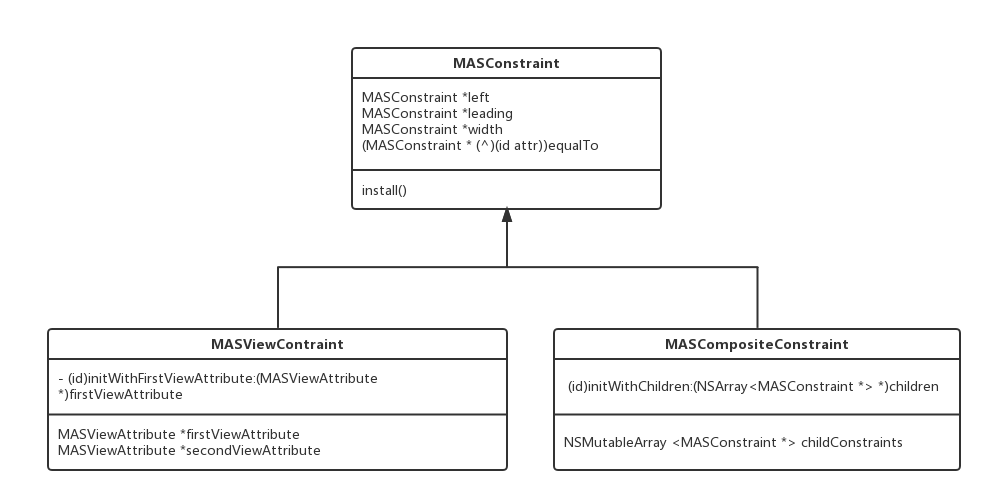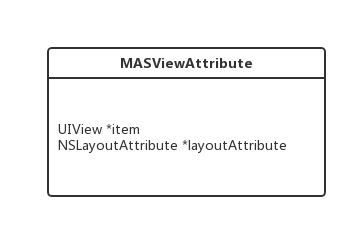走进 Masonry
2017-03-07
先简单看一下 Masonry 主要的设计以及 Class 结构方法

Masonry 采用了经典的 Composite 设计模式,如果你还不清楚该设计模式,你需要 Google 看看对应的文章
看完了上面类设计图,我们开始跟踪程序
Masonry 开始于这样的代码结构
- (void)viewDidLoad {
[super viewDidLoad];
UIView *aview = [[UIView alloc] init];
[self.view addSubview:aview];
[aview mas_makeConstraints:^(MASConstraintMaker *make) {
make.top.equalTo(self.view);
make.left.right.equalTo(@0);
}];
}
其中, mas_makeConstraints 方法在 View+MASAdditions 被定义
- (NSArray *)mas_makeConstraints:(void(^)(MASConstraintMaker *))block {
self.translatesAutoresizingMaskIntoConstraints = NO;
MASConstraintMaker *constraintMaker = [[MASConstraintMaker alloc] initWithView:self];
block(constraintMaker);
return [constraintMaker install];
}
代码的第二行创建了一个 MASConstraintMaker(MASConstraintMaker 与 MASConstraint 一样 定义了 left right 等方法) 对象,也就是我们能够进行链式操作
make.left.right.equalTo 开始对象
第三行执行代码 block(constraintMaker), 也就是执行我们写的 make.left.right.equalTo 的代码
下面开始解析这一段链式代码
MASConstraintMaker 内部有一个 NSMutableArray<MASConstraint *> *constraints 对象, constraints 保存了每一条 make 出来的信息,比如如果你写这样的代码
make.top.equalTo(self.view);
make.left.right.equalTo(@0);
constraints 将会保存 2 个对象,第一个对象记录了 make.top.equalTo(self.view) 的所有信息,第二个对象记录了 make.left.right.equalTo(@0) 的所有信息,而对象的数据结构就是上图中的 MASViewConstraint 和 MASCompositeConstraint
接下来,我们看一看它是如何保存这个信息的:
先看第一个层级:
make.top
调用顺序如下:
- (MASConstraint *)top {
return [self addConstraintWithLayoutAttribute:NSLayoutAttributeTop];
}
- (MASConstraint *)addConstraintWithLayoutAttribute:(NSLayoutAttribute)layoutAttribute {
return [self constraint:nil addConstraintWithLayoutAttribute:layoutAttribute];
}
- (MASConstraint *)constraint:(MASConstraint *)constraint addConstraintWithLayoutAttribute:(NSLayoutAttribute)layoutAttribute {
MASViewAttribute *viewAttribute = [[MASViewAttribute alloc] initWithView:self.view layoutAttribute:layoutAttribute];
MASViewConstraint *newConstraint = [[MASViewConstraint alloc] initWithFirstViewAttribute:viewAttribute];
// if ([constraint isKindOfClass:MASViewConstraint.class]) {
// //replace with composite constraint
// NSArray *children = @[constraint, newConstraint];
// MASCompositeConstraint *compositeConstraint = [[MASCompositeConstraint alloc] initWithChildren:children];
// compositeConstraint.delegate = self;
// [self constraint:constraint shouldBeReplacedWithConstraint:compositeConstraint];
// return compositeConstraint;
// }
if (!constraint) {
newConstraint.delegate = self;
[self.constraints addObject:newConstraint];
}
return newConstraint;
}
其中上面注释的代码是本次调用不会运行的,后面会讲到注释掉的代码的作用
介绍一下 MASViewAttribute
MASViewAttribute 的 Class 结构如下图

上面的 item 字段,Masonry 上给的是 id 字段,因为 还有 viewController 的 topLayoutGuide 属性,这里 为了方便理解,可以把它直接看作 UIView
剩余的代码很简单,只是根据 top 这个属性,新建你一个 MASViewConstraint 的对象,然后为 MASViewConstraint1 创建 firstViewAttribute (这里还没有生成 secondViewAttribute`)
相当于下面的代码:
//self 是外部的 [aView mas_makeConstraints] 的 aView
MASViewConstraint *newConstraint.firstViewAttribute.item = self.view //外部调用 make.top 的 aview
newConstraint.firstViewAttribute.layoutConstraint = NSLayoutAttributeTop
最后 把 这个 newConstraint 加入到 MASConstraintMaker(make) 的 constraints 对象中
这样 完成了 make.top 的操作 (.equalTo 的操作稍后介绍)
接着,我们看第二句
make.left.right
其中,前面半句 make.left 和上面的步骤是一样的,不同的地方在于后面 .right
首先,前半句 make.left 返回了 MASAttribute(MASViewConstraint)对象,已经不是 MASConstraintMaker(make) 对象了。所以 我们需要看看 MASViewConstraint 的 left 方法做了那些事情。
调用顺序如下:
- (MASConstraint *)left {
return [self addConstraintWithLayoutAttribute:NSLayoutAttributeLeft];
}
- (MASConstraint *)addConstraintWithLayoutAttribute:(NSLayoutAttribute)layoutAttribute {
NSAssert(!self.hasLayoutRelation, @"Attributes should be chained before defining the constraint relation");
return [self.delegate constraint:self addConstraintWithLayoutAttribute:layoutAttribute]; //这里 delegate 指向了刚刚的 `MASConstraintMaker(make)` 对象
}
- (MASConstraint *)constraint:(MASConstraint *)constraint addConstraintWithLayoutAttribute:(NSLayoutAttribute)layoutAttribute {
MASViewAttribute *viewAttribute = [[MASViewAttribute alloc] initWithView:self.view layoutAttribute:layoutAttribute];
MASViewConstraint *newConstraint = [[MASViewConstraint alloc] initWithFirstViewAttribute:viewAttribute];
if ([constraint isKindOfClass:MASViewConstraint.class]) {
//replace with composite constraint
NSArray *children = @[constraint, newConstraint];
MASCompositeConstraint *compositeConstraint = [[MASCompositeConstraint alloc] initWithChildren:children];
compositeConstraint.delegate = self;
[self constraint:constraint shouldBeReplacedWithConstraint:compositeConstraint];
return compositeConstraint;
}
// if (!constraint) {
// newConstraint.delegate = self;
// [self.constraints addObject:newConstraint];
// }
return newConstraint;
}
这一次最后这个函数的执行了上阶段注释的代码,这段代码和之前的代码大致相同,也是先创建了一个 MASViewConstraint 的对象, 但是,不同之处在于这次组成了一个 MASCompositeConstraint,MASCompositeConstraint 的 childConstraints 放了上次的 make.left 的信息和这次 make.right 的信息,并且 用 MASCompositeConstraint 替换了原来的 MASViewConstraint。 (这里希望你理解 Composite 设计模式的精髓, 因为 类似这种make.left.right.top三连以上的链式句式 MASCompositeConstraint 里面放的是两个MASCompositeConstraint)
最后是 equalTo 的语法
先看一下 equalTo 的定义
- (MASConstraint * (^)(id attr))equalTo
equal 是一个 返回 MASConstraint * 里面包括一个参数 attr 名为 equalTo 的 block
之所以是 attr 被定义为 id 是因为 我们可以写出这样的代码
make.left.equalTo(self.view) 或者 make.left.equalTo(@0)
整个 equalTo 的调用顺序如下(self 是 MASConstraint对象)
- (MASConstraint * (^)(id))equalTo {
return ^id(id attribute) {
return self.equalToWithRelation(attribute, NSLayoutRelationEqual);
};
}
- (MASConstraint * (^)(id, NSLayoutRelation))equalToWithRelation {
return ^id(id attribute, NSLayoutRelation relation) {
// if ([attribute isKindOfClass:NSArray.class]) {
// NSAssert(!self.hasLayoutRelation, @"Redefinition of constraint relation");
// NSMutableArray *children = NSMutableArray.new;
// for (id attr in attribute) {
// MASViewConstraint *viewConstraint = [self copy];
// viewConstraint.layoutRelation = relation;
// viewConstraint.secondViewAttribute = attr;
// [children addObject:viewConstraint];
// }
// MASCompositeConstraint *compositeConstraint = [[MASCompositeConstraint alloc] initWithChildren:children];
// compositeConstraint.delegate = self.delegate;
// [self.delegate constraint:self shouldBeReplacedWithConstraint:compositeConstraint];
// return compositeConstraint;
// } else {
NSAssert(!self.hasLayoutRelation || self.layoutRelation == relation && [attribute isKindOfClass:NSValue.class], @"Redefinition of constraint relation");
self.layoutRelation = relation;
self.secondViewAttribute = attribute;
return self;
// }
};
}
这里 我只列举出了 MASViewConstraint 的 equalToWithRelation, 因为 Composite 模式中定义的 equalToWithRelation 其实就是让所有的子类依次去执行 equalToWithRelation,另外 我并没有怎么使用过 equalTo(attr) attr 是一个 NSArray 类型,所以 注释的代码没有去钻研。
在 MASViewConstraint 的 secondViewAttribute 被定义如下
- (void)setSecondViewAttribute:(id)secondViewAttribute {
if ([secondViewAttribute isKindOfClass:NSValue.class]) {
[self setLayoutConstantWithValue:secondViewAttribute];
} else if ([secondViewAttribute isKindOfClass:MAS_VIEW.class]) {
_secondViewAttribute = [[MASViewAttribute alloc] initWithView:secondViewAttribute layoutAttribute:self.firstViewAttribute.layoutAttribute];
} else if ([secondViewAttribute isKindOfClass:MASViewAttribute.class]) {
_secondViewAttribute = secondViewAttribute;
} else {
NSAssert(NO, @"attempting to add unsupported attribute: %@", secondViewAttribute);
}
}
这也是为什么我们能够写这样的代码
make.left.equalTo(@0) // make.left.equalTo(self.view)
equalTo 后面可以接 NSNumber 和 UIView 甚至是 NSValue
好了,到此为止,所有的链式代码已经解读完毕,至于 类似的 offset 道理都一样,相对简单,这里不再做过多的陈述
最后是 [constraintMaker install] 的代码
调用函数如下(self 是 MASConstraintMaker):
- (NSArray *)install {
if (self.removeExisting) {
NSArray *installedConstraints = [MASViewConstraint installedConstraintsForView:self.view];
for (MASConstraint *constraint in installedConstraints) {
[constraint uninstall];
}
}
NSArray *constraints = self.constraints.copy;
for (MASConstraint *constraint in constraints) {
constraint.updateExisting = self.updateExisting;
[constraint install];
}
[self.constraints removeAllObjects];
return constraints;
}
上面的代码 removeExisting 是 mas_remakeConstraints 做的事情, Masonry 用一个 MutableSet 记录了所有通过 Masonry 创建的 constraint, 这个 set 被定义在了 MASConstraints.m 里面
#define MAS_VIEW UIView
@interface MAS_VIEW (MASConstraints)
@property (nonatomic, readonly) NSMutableSet *mas_installedConstraints;
@end
@implementation MAS_VIEW (MASConstraints)
static char kInstalledConstraintsKey;
- (NSMutableSet *)mas_installedConstraints {
NSMutableSet *constraints = objc_getAssociatedObject(self, &kInstalledConstraintsKey);
if (!constraints) {
constraints = [NSMutableSet set];
objc_setAssociatedObject(self, &kInstalledConstraintsKey, constraints, OBJC_ASSOCIATION_RETAIN_NONATOMIC);
}
return constraints;
}
@end
每次通过 Masonry 添加最后添加成功的 constraint 都会被加入到这个 set 里面
函数的最后把所有添加到 MASConstraintMaker 的 constraints 的数组清空(因为所有的 constraint 都已经被加入到了 View 里)
最后 我们看看 install 的代码
NSArray *constraints = self.constraints.copy; //这里为什么用 copy 我也不是很清楚作者是怎么想的,可能是出于线程安全的考虑
for (MASConstraint *constraint in constraints) {
constraint.updateExisting = self.updateExisting;
[constraint install];
}
[constraint install] 也是利用了 Composite 设计模式的特性(希望你能真正理解 Composite )
MASViewConstraint 的 install 实现:
- (void)install {
if (self.hasBeenInstalled) {
return;
}
if ([self supportsActiveProperty] && self.layoutConstraint) {
self.layoutConstraint.active = YES;
[self.firstViewAttribute.view.mas_installedConstraints addObject:self];
return;
}
MAS_VIEW *firstLayoutItem = self.firstViewAttribute.item;
NSLayoutAttribute firstLayoutAttribute = self.firstViewAttribute.layoutAttribute;
MAS_VIEW *secondLayoutItem = self.secondViewAttribute.item;
NSLayoutAttribute secondLayoutAttribute = self.secondViewAttribute.layoutAttribute;
// alignment attributes must have a secondViewAttribute
// therefore we assume that is refering to superview
// eg make.left.equalTo(@10)
if (!self.firstViewAttribute.isSizeAttribute && !self.secondViewAttribute) {
secondLayoutItem = self.firstViewAttribute.view.superview;
secondLayoutAttribute = firstLayoutAttribute;
}
////---------截止这里的代码都很好理解 就是在配好 NSLayoutConstraint 的所有 item 和 attribute, 而这些东西在之前的 make 链式语法都组装好了---------////
////---------其中 masonry 自己的注释也写明白了 为什么 make.left.equalTo(@10) 这样的代码能够被组装成 NSLayoutConstraint---------////
//MASLayoutConstraint 可以简单的认为就是 NSLayoutConstraint
MASLayoutConstraint *layoutConstraint
= [MASLayoutConstraint constraintWithItem:firstLayoutItem
attribute:firstLayoutAttribute
relatedBy:self.layoutRelation
toItem:secondLayoutItem
attribute:secondLayoutAttribute
multiplier:self.layoutMultiplier
constant:self.layoutConstant];
layoutConstraint.priority = self.layoutPriority;
layoutConstraint.mas_key = self.mas_key;
if (self.secondViewAttribute.view) {
MAS_VIEW *closestCommonSuperview = [self.firstViewAttribute.view mas_closestCommonSuperview:self.secondViewAttribute.view];
NSAssert(closestCommonSuperview,
@"couldn't find a common superview for %@ and %@",
self.firstViewAttribute.view, self.secondViewAttribute.view);
self.installedView = closestCommonSuperview;
} else if (self.firstViewAttribute.isSizeAttribute) {
self.installedView = self.firstViewAttribute.view;
} else {
self.installedView = self.firstViewAttribute.view.superview;
}
MASLayoutConstraint *existingConstraint = nil;
if (self.updateExisting) {
existingConstraint = [self layoutConstraintSimilarTo:layoutConstraint];
}
if (existingConstraint) {
// just update the constant
existingConstraint.constant = layoutConstraint.constant;
self.layoutConstraint = existingConstraint;
} else {
[self.installedView addConstraint:layoutConstraint];
self.layoutConstraint = layoutConstraint;
[firstLayoutItem.mas_installedConstraints addObject:self];
}
}
这段代码是 install 的最后一个步骤,整体来说比较简单,就是把 MASViewConstraint 变成 NSLayoutConstraint 加入到具体的 UIView 当中,如果你还不清楚怎么用系统的 API 写 AutoLayout 的话,可以点这里。
其中 mas_closestCommonSuperview 是找 firstViewAttribute.view 和 secondViewAttribute.view 的共同公共的父 View, 这里的算法很简单,只是单纯的遍历
- (instancetype)mas_closestCommonSuperview:(MAS_VIEW *)view {
MAS_VIEW *closestCommonSuperview = nil;
MAS_VIEW *secondViewSuperview = view;
while (!closestCommonSuperview && secondViewSuperview) {
MAS_VIEW *firstViewSuperview = self;
while (!closestCommonSuperview && firstViewSuperview) {
if (secondViewSuperview == firstViewSuperview) {
closestCommonSuperview = secondViewSuperview;
}
firstViewSuperview = firstViewSuperview.superview;
}
secondViewSuperview = secondViewSuperview.superview;
}
return closestCommonSuperview;
}
截止为止,Masonry 的 mas_makeConstraints 的整个过程全部分析完毕,对于剩下的 mas_remakeConstraints 和 mas_updateConstraints 大同小异,这里不再做更多陈述